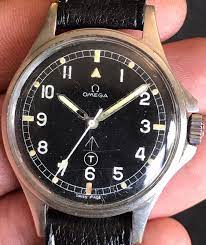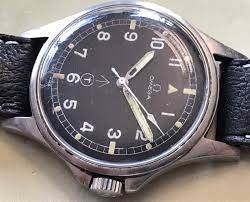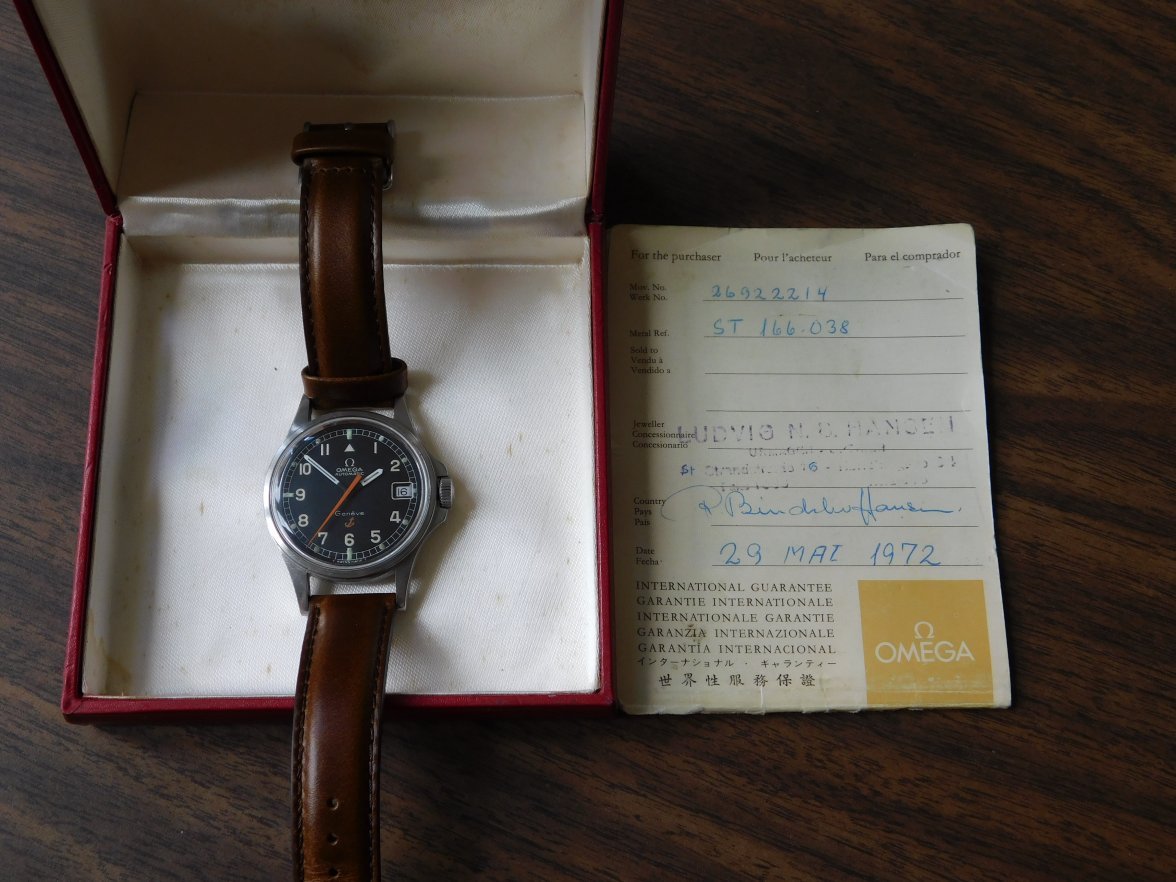Dr.Sascha
·These are just beautiful pieces all around, and it's nice to see them getting more attention. I think of these as the "companion" watches to the Seamaster 300s, especially given that the most desirable models share the famed 565 movement.
This is another style that came in a variety of cases, dial designs, and movements. Since they seem to be rising in value and decreasing in availability, more redials and frankens are appearing. Given the relatively limited run of them, demand will certainly increase. A few years ago, you could get the more common models for $6-700, Now those are likely to run you at least $1500-1700, with rarer ones or pristine examples going for $2000-2500 or more. That's for the 565 caliber models, though the 552s can also run in that range. Hand-winders, as with other models, are a bit more affordable, and can still be gotten for 1-1.5k (for now). So, it's probably worth giving a rundown of the reference dials and the distinguishing characteristics.
Common features to all:
First issued 1968, produced until 1972(?)
Designation: Officially the Geneve Admiralty, also known as the Ancorina, Ancoretta, or Anchor (though some models, including the first iteration, did not have the anchor logo).
Case: Asymmetrical case. References are:
I: Non-bezelled
166.038 "longhorn," 17mm lugs
166.083 "shorthorn," 18mm lugs
135.015 "longhorn," 17mm lugs
"Shorthorns" are the rarer version, with "Longhorns" generally more common.
The rarest models in both cases are military dials, in black and white, featuring the 565 mvt.
II: Bezelled
165.054, 18mm lugs
135.042, 18mm lugs
Crown: large, protected signed crown, reminiscent of other dive/military watches from the era (e.g. Rolex, Lemania HS9, Heuer Professional). This is one of the most distinctive elements of Admiralties, and distinguishes it from other military-dialed Omegas (themselves a rarity) in particular.
Caseback: Unsigned, screwback caseback, brushed or polished (in some cases, a mixture) with "waterproof" inscription (domed in automatic mvts., flat in hand-winders).
Signed Dial: Applied Omega logo in most models, painted in military dials.
Movement: 565 automatic movement w/date, 552 movement w/o date, 601 or 613 (w/date) hand-winder.
Batons: Broad, two-tone batons with in-filled lume, hour baton wider than minute baton. Black and white on blue, black, and non-bezelled grey dials, white and black on white and bezelled grey dials.
Sweep Second: Elongated triangular sweep second, broader at base than at pivot. This is typically orange, but bezelled models have blue or burgundy, to match dial. This is common in all models, regardless of year, however there are some variations (e.g. a blue-dialed one where the pivot area is rounded rather than straight). NB: due to variations in dial-size, layout, and year of production, the apparent length of these in proportion to the dial seems to have varied. Sometimes, it reaches just to the seconds track, in others, half-way in, and in some, to its far edge or just beyond it.
Brushed finish case on sides and front of lugs.
Polished finish on front rim of non-bezelled 166.083 ("Shorthorn") and 165.038 ("Longhorn").
"T Swiss Made T" on bottom edge of dial.
In rough descending order of rarity, as near as I can determine, here's the line-up. It should be noted that these are all quite rare, so the distinctions are relative. #1-4 ("longhorns") seem to have been produced in especially limited numbers, and the military-dialed automatics are the rarest of the "shorthorns."
Category 1: Non-bezelled, 166.038 "longhorn" 17mm lugs and 166.083 "shorthorn" 18mm lugs.
1. (rarest) black military railroad dial in 166.038 "Longhorn" case. 565 mvt. 17mm lugs, elegantly elongated, presumably to accommodate the original metal bracelet end-pieces. Painted Arabic numerals w/triangle at 12, slanted orange anchor. Rectangular tritium lumes at cardinals, round tritium lumes elsewhere. NB: both the shorthorns and longhorn 565/552 military-dialed version seem to have been produced, albeit in limited numbers, throughout the lifespan of the Admiralty model (1968-1972).
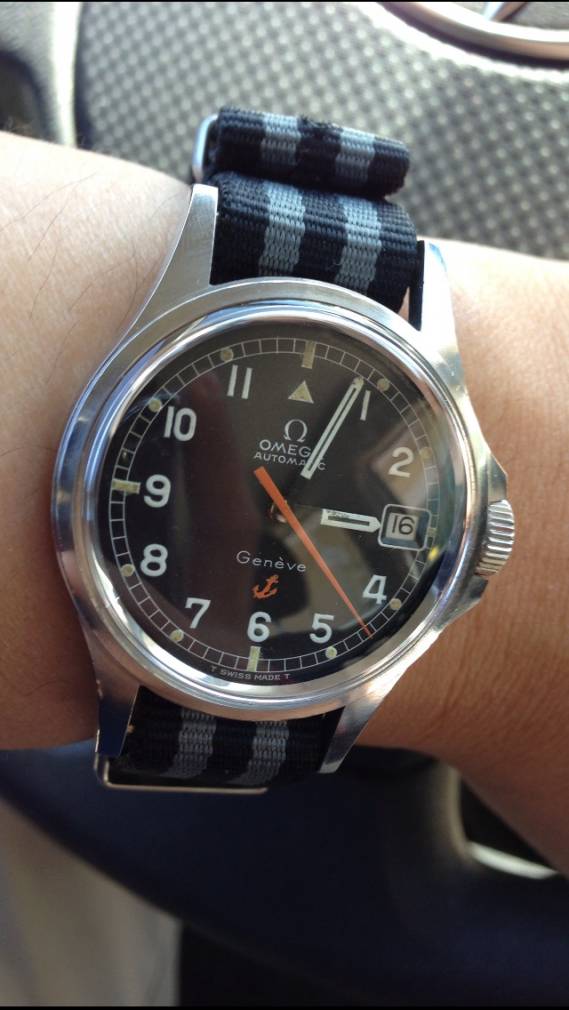
2. (rarest): 166.083 "shorthorn," 565 mvt., with black military dial, painted arabic numerals w/triangle at 12, slanted anchor. Brushed caseback. 18mm lugs. NB: this might also come in white, but no confirmation of that (if so, they're even rarer than the black-dial version).

3. (v. rare) 165.083 "Shorthorn" case, 552 calibre, otherwise same as #1 above, black military dial, 18mm lugs.

4. 1968 (1st iteration) (v. rare): As #2, above, but in blue dial without anchor.

5. (v. rare) Same as #3 above, but with 552 cal. movement, slanted orange anchor.

6. (rare): 166.083 "Longhorn," 17mm lugs, black dial, 565 mvt., slanted orange anchor, sub-second demarcations, applied Omega logo, applied rhodium furniture, horizontal tritium lumes at cardinals (round dots elsewhere), orange hour hashes. These black-dial 565 longhorns seem to be the rarest of the models produced with applied furniture.

7. (rare) 135.035 "longhorn" or 135.015 "shorthorn," 601 or 603 handwinder, black dial; otherwise as #2 above. The black-dial shorthorn version seems to be the rarest of the non-military hand-winders.


8. (more common). Ref. 135.015 "longhorn", military dial, hand-winder in cal. 601 or 613 w/date. 17mm lugs. These seem to have been adopted and issued by Queensland Rail, which may account for why they are a bit more common than the 565 or 552 military-dial models.

9. (more common) Same as #3, 166.038 "Longhorn" but in white (the rarer of the two) or grey, in 565 and 552 versions. Note the red sweep second and hour hashes instead of the more typical orange.


Note, the grey dial is also occasionally seen in the 166.083 "Shorthorn" (18mm lug) case.

Bezelled (1969-72)
10. (v. rare) 1969 166.054, 552 mvt., and 135.042, 501 mvt. 18mm, burgundy dial w/no subsecond demarcations, longer applied rhodium markers at cardinals, otherwise painted lumes, straight white anchor or anchorless.
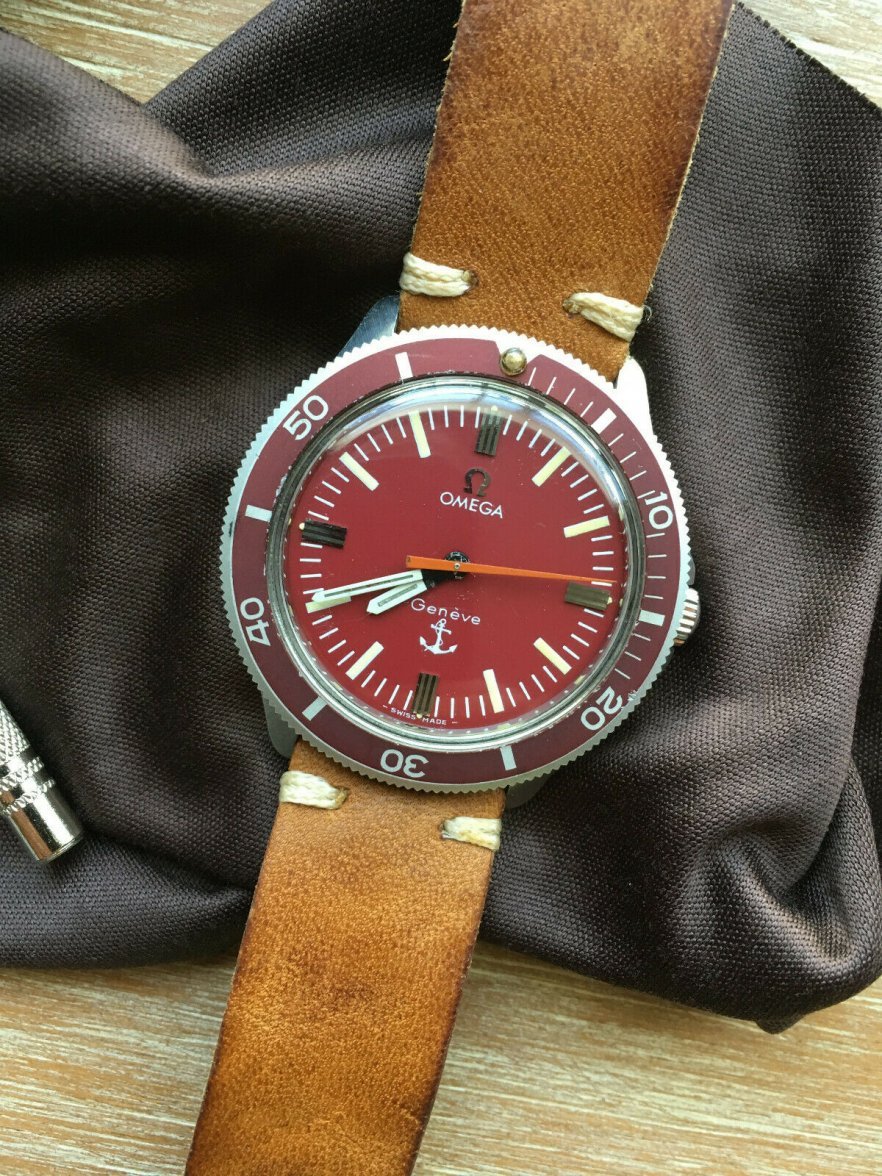
11. (rare) as #7 above, but white dial, 565 mvt. Applied rhodium markers all around, straight, painted anchor.

12. (rare), as above, but blue dial, straight white or orange straight anchor or no anchor. Note the variation on the sweep second with the wider pivot.


13. (most common version), 135.042, 565 or 552 mvt. as above but with grey sunburst dial. These seem to have been produced in larger numbers, and are the ones that come up for sale most commonly. Still pretty rare though, and ones in good condition (i.e. not excessive ghosting on the bezel) are rarer still.

Any other versions I'm missing here? I've found an image of what looks to be a military version, but can find no further information (working on it).
And this interesting longhorn with very unique furniture, but spot-on in every other aspect--case (166.038), hands, mvt., crown.

And some odd offshoots (e.g. a black dial with a blue bezel), but I suspect the latter are frankens.
One detail to keep an eye out for is the anchor. Early year originals either have no anchor or a slanted orange one with a rope entwined, later ones can also be anchorless, but more typically have a straight black anchor with rope entwined. In all cases, the anchor is solid and slim.
Another important detail is the bezel. Similarly to the SM120, this should have hash marks only to 20, thick hashes at 5 and 15, and a contrasting outer edge (dark in grey bezels, light in blue ones).
So, for example, this one has the wrong anchor design and the misplacement of "T Swiss Made T"

Whereas on this one, the anchor is thick and too small.

This one doesn't look right either--the bezel is bakelite and looks brand new. But the dial and anchor are otherwise correct, and the blue sweep second is not out of place either:
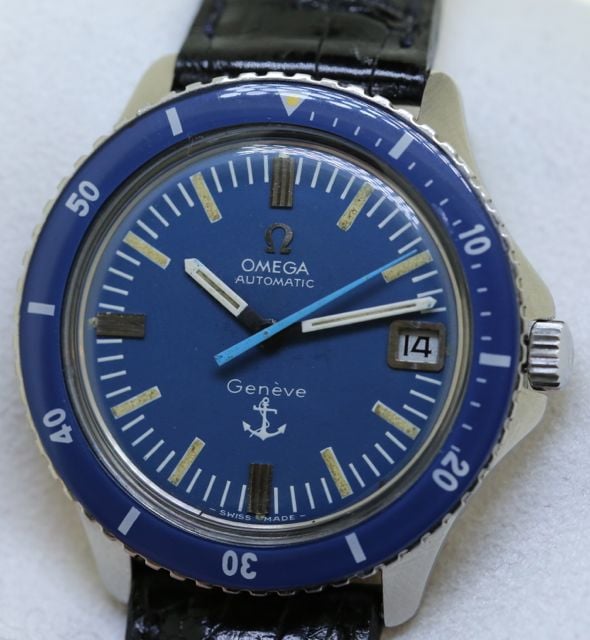
This is just a first pass, so please do correct me or add to this!
This is another style that came in a variety of cases, dial designs, and movements. Since they seem to be rising in value and decreasing in availability, more redials and frankens are appearing. Given the relatively limited run of them, demand will certainly increase. A few years ago, you could get the more common models for $6-700, Now those are likely to run you at least $1500-1700, with rarer ones or pristine examples going for $2000-2500 or more. That's for the 565 caliber models, though the 552s can also run in that range. Hand-winders, as with other models, are a bit more affordable, and can still be gotten for 1-1.5k (for now). So, it's probably worth giving a rundown of the reference dials and the distinguishing characteristics.
Common features to all:
First issued 1968, produced until 1972(?)
Designation: Officially the Geneve Admiralty, also known as the Ancorina, Ancoretta, or Anchor (though some models, including the first iteration, did not have the anchor logo).
Case: Asymmetrical case. References are:
I: Non-bezelled
166.038 "longhorn," 17mm lugs
166.083 "shorthorn," 18mm lugs
135.015 "longhorn," 17mm lugs
"Shorthorns" are the rarer version, with "Longhorns" generally more common.
The rarest models in both cases are military dials, in black and white, featuring the 565 mvt.
II: Bezelled
165.054, 18mm lugs
135.042, 18mm lugs
Crown: large, protected signed crown, reminiscent of other dive/military watches from the era (e.g. Rolex, Lemania HS9, Heuer Professional). This is one of the most distinctive elements of Admiralties, and distinguishes it from other military-dialed Omegas (themselves a rarity) in particular.
Caseback: Unsigned, screwback caseback, brushed or polished (in some cases, a mixture) with "waterproof" inscription (domed in automatic mvts., flat in hand-winders).
Signed Dial: Applied Omega logo in most models, painted in military dials.
Movement: 565 automatic movement w/date, 552 movement w/o date, 601 or 613 (w/date) hand-winder.
Batons: Broad, two-tone batons with in-filled lume, hour baton wider than minute baton. Black and white on blue, black, and non-bezelled grey dials, white and black on white and bezelled grey dials.
Sweep Second: Elongated triangular sweep second, broader at base than at pivot. This is typically orange, but bezelled models have blue or burgundy, to match dial. This is common in all models, regardless of year, however there are some variations (e.g. a blue-dialed one where the pivot area is rounded rather than straight). NB: due to variations in dial-size, layout, and year of production, the apparent length of these in proportion to the dial seems to have varied. Sometimes, it reaches just to the seconds track, in others, half-way in, and in some, to its far edge or just beyond it.
Brushed finish case on sides and front of lugs.
Polished finish on front rim of non-bezelled 166.083 ("Shorthorn") and 165.038 ("Longhorn").
"T Swiss Made T" on bottom edge of dial.
In rough descending order of rarity, as near as I can determine, here's the line-up. It should be noted that these are all quite rare, so the distinctions are relative. #1-4 ("longhorns") seem to have been produced in especially limited numbers, and the military-dialed automatics are the rarest of the "shorthorns."
Category 1: Non-bezelled, 166.038 "longhorn" 17mm lugs and 166.083 "shorthorn" 18mm lugs.
1. (rarest) black military railroad dial in 166.038 "Longhorn" case. 565 mvt. 17mm lugs, elegantly elongated, presumably to accommodate the original metal bracelet end-pieces. Painted Arabic numerals w/triangle at 12, slanted orange anchor. Rectangular tritium lumes at cardinals, round tritium lumes elsewhere. NB: both the shorthorns and longhorn 565/552 military-dialed version seem to have been produced, albeit in limited numbers, throughout the lifespan of the Admiralty model (1968-1972).

2. (rarest): 166.083 "shorthorn," 565 mvt., with black military dial, painted arabic numerals w/triangle at 12, slanted anchor. Brushed caseback. 18mm lugs. NB: this might also come in white, but no confirmation of that (if so, they're even rarer than the black-dial version).

3. (v. rare) 165.083 "Shorthorn" case, 552 calibre, otherwise same as #1 above, black military dial, 18mm lugs.

4. 1968 (1st iteration) (v. rare): As #2, above, but in blue dial without anchor.

5. (v. rare) Same as #3 above, but with 552 cal. movement, slanted orange anchor.

6. (rare): 166.083 "Longhorn," 17mm lugs, black dial, 565 mvt., slanted orange anchor, sub-second demarcations, applied Omega logo, applied rhodium furniture, horizontal tritium lumes at cardinals (round dots elsewhere), orange hour hashes. These black-dial 565 longhorns seem to be the rarest of the models produced with applied furniture.

7. (rare) 135.035 "longhorn" or 135.015 "shorthorn," 601 or 603 handwinder, black dial; otherwise as #2 above. The black-dial shorthorn version seems to be the rarest of the non-military hand-winders.


8. (more common). Ref. 135.015 "longhorn", military dial, hand-winder in cal. 601 or 613 w/date. 17mm lugs. These seem to have been adopted and issued by Queensland Rail, which may account for why they are a bit more common than the 565 or 552 military-dial models.
9. (more common) Same as #3, 166.038 "Longhorn" but in white (the rarer of the two) or grey, in 565 and 552 versions. Note the red sweep second and hour hashes instead of the more typical orange.


Note, the grey dial is also occasionally seen in the 166.083 "Shorthorn" (18mm lug) case.

Bezelled (1969-72)
10. (v. rare) 1969 166.054, 552 mvt., and 135.042, 501 mvt. 18mm, burgundy dial w/no subsecond demarcations, longer applied rhodium markers at cardinals, otherwise painted lumes, straight white anchor or anchorless.

11. (rare) as #7 above, but white dial, 565 mvt. Applied rhodium markers all around, straight, painted anchor.

12. (rare), as above, but blue dial, straight white or orange straight anchor or no anchor. Note the variation on the sweep second with the wider pivot.


13. (most common version), 135.042, 565 or 552 mvt. as above but with grey sunburst dial. These seem to have been produced in larger numbers, and are the ones that come up for sale most commonly. Still pretty rare though, and ones in good condition (i.e. not excessive ghosting on the bezel) are rarer still.

Any other versions I'm missing here? I've found an image of what looks to be a military version, but can find no further information (working on it).
And this interesting longhorn with very unique furniture, but spot-on in every other aspect--case (166.038), hands, mvt., crown.

And some odd offshoots (e.g. a black dial with a blue bezel), but I suspect the latter are frankens.
One detail to keep an eye out for is the anchor. Early year originals either have no anchor or a slanted orange one with a rope entwined, later ones can also be anchorless, but more typically have a straight black anchor with rope entwined. In all cases, the anchor is solid and slim.
Another important detail is the bezel. Similarly to the SM120, this should have hash marks only to 20, thick hashes at 5 and 15, and a contrasting outer edge (dark in grey bezels, light in blue ones).
So, for example, this one has the wrong anchor design and the misplacement of "T Swiss Made T"

Whereas on this one, the anchor is thick and too small.

This one doesn't look right either--the bezel is bakelite and looks brand new. But the dial and anchor are otherwise correct, and the blue sweep second is not out of place either:

This is just a first pass, so please do correct me or add to this!
Edited:
